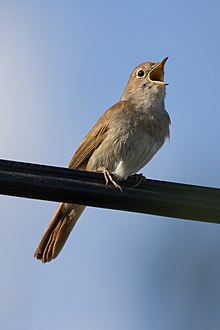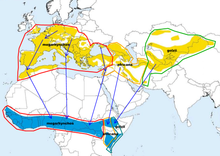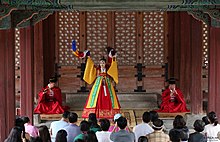| Common nightingale | |
|---|---|

| |
| Song | |
| Conservation status | |
 Least Concern (IUCN 3.1) | |
| Scientific classification | |
| Domain: | Eukaryota |
| Kingdom: | Animalia |
| Phylum: | Chordata |
| Class: | Aves |
| Order: | Passeriformes |
| Family: | Muscicapidae |
| Genus: | Luscinia |
| Species: | L. megarhynchos |
| Binomial name | |
| Luscinia megarhynchos Brehm, 1831 | |

| |
| Range of L. megarhynchos Breeding Non-breeding | |
The common nightingale, rufous nightingale or simply nightingale (Luscinia megarhynchos), is a small passerine bird which is best known for its powerful and beautiful song. It was formerly classed as a member of the thrush family Turdidae, but is now more generally considered to be an Old World flycatcher, Muscicapidae. It belongs to a group of more terrestrial species, often called chats.
Etymology
"Nightingale" is derived from "night" and the Old English galan, "to sing". The genus name Luscinia is Latin for "nightingale" and megarhynchos is from Ancient Greek megas, "great" and rhunkhos "bill".
Subspecies

- western nightingale (L. m. megarhynchos) - Western Europe, North Africa and Asia Minor, wintering in tropical Africa
- Caucasian nightingale (L. m. africana) - The Caucasus and eastern Turkey to southwestern Iran and Iraq, wintering in East Africa
- eastern nightingale (L. m. golzii) - The Aral Sea to Mongolia, wintering in coastal East Africa
Description


The common nightingale is slightly larger than the European robin, at 15–16.5 cm (5.9–6.5 in) length. It is plain brown above except for the reddish tail. It is buff to white below. The sexes are similar. The eastern subspecies (L. m. golzi) and the Caucasian subspecies (L. m. africana) have paler upper parts and a stronger face-pattern, including a pale supercilium. The song of the male nightingale has been described as one of the most beautiful sounds in nature, inspiring songs, fairy tales, opera, books, and a great deal of poetry. However, historically most people were not aware that female nightingales do not sing.
Distribution and habitat
It is a migratory insectivorous species breeding in forest and scrub in Europe and the Palearctic, and wintering in Sub-Saharan Africa. It is not found naturally in the Americas. The distribution is more southerly than the very closely related thrush nightingale Luscinia luscinia. It nests on or near the ground in dense vegetation. Research in Germany found that favoured breeding habitat of nightingales was defined by a number of geographical factors.
- less than 400 m (1,300 ft) above mean sea level
- mean air temperature during the growing season above 14 °C (57 °F)
- more than 20 days/year on which temperatures exceed 25 °C (77 °F)
- annual precipitation less than 750 millimetres (30 in)
- aridity index lower than 0.35
- no closed canopy
In the U.K., the bird is at the northern limit of its range which has contracted in recent years, placing it on the red list for conservation. Despite local efforts to safeguard its favoured coppice and scrub habitat, numbers fell by 53 percent between 1995 and 2008. A survey conducted by the British Trust for Ornithology in 2012 and 2013 recorded some 3,300 territories, with most of these clustered in a few counties in the southeast of England, notably Kent, Essex, Suffolk, and East and West Sussex.
By contrast, the European breeding population is estimated at between 3.2 and 7 million pairs, giving it green conservation status (least concern).
Behaviour and ecology
Common nightingales are so named because they frequently sing at night as well as during the day. The name has been used for more than 1,000 years, being highly recognisable even in its Old English form nihtegale, which means "night songstress". Early writers assumed the female sang when it is in fact the male. The song is loud, with an impressive range of whistles, trills and gurgles. Its song is particularly noticeable at night because few other birds are singing. This is why its name includes "night" in several languages. Only unpaired males sing regularly at night, and nocturnal song probably serves to attract a mate. Singing at dawn, during the hour before sunrise, is assumed to be important in defending the bird's territory. Nightingales sing even more loudly in urban or near-urban environments, in order to overcome the background noise. The most characteristic feature of the song is a loud whistling crescendo that is absent from the song of its close relative, the thrush nightingale (Luscinia luscinia). It has a frog-like alarm call.
The bird is a host of the acanthocephalan intestinal parasite Apororhynchus silesiacus.
Cultural connotations
Further information: Birds in cultureThe common nightingale is an important symbol for poets from a variety of ages, and has taken on a number of symbolic connotations. Homer evokes Aëdon the nightingale in Odyssey, suggesting the myth of Philomela and Procne (one of whom, depending on the myth's version, is turned into a nightingale). This myth is the focus of Sophocles' tragedy, Tereus, of which only fragments remain. Ovid, too, in his Metamorphoses, includes the most popular version of this myth, imitated and altered by later poets, including Chrétien de Troyes, Geoffrey Chaucer, John Gower, and George Gascoigne. T.S. Eliot's "The Waste Land" also evokes the common nightingale's song (and the myth of Philomela and Procne). Because of the violence associated with the myth, the nightingale's song was long interpreted as a lament.
The common nightingale has also been used as a symbol of poets or their poetry. Poets chose the nightingale as a symbol because of its creative and seemingly spontaneous song. Aristophanes's The Birds and Callimachus both evoke the bird's song as a form of poetry. Virgil compares the mourning of Orpheus to the “lament of the nightingale”.
In Sonnet 102 Shakespeare compares his love poetry to the song of the common nightingale (Philomel):
- "Our love was new, and then but in the spring,
- When I was wont to greet it with my lays;
- As Philomel in summer's front doth sing,
- And stops his pipe in growth of riper days:"
During the Romantic era the bird's symbolism changed once more: poets viewed the nightingale not only as a poet in his own right, but as “master of a superior art that could inspire the human poet”. For some romantic poets, the nightingale even began to take on qualities of the muse. The nightingale has a long history with symbolic associations ranging from "creativity, the muse, nature's purity, and, in Western spiritual tradition, virtue and goodness." Coleridge and Wordsworth saw the nightingale more as an instance of natural poetic creation: the nightingale became a voice of nature. John Keats' "Ode to a Nightingale" pictures the nightingale as an idealized poet who has achieved the poetry that Keats longs to write. Invoking a similar conception of the nightingale, Shelley wrote in his “A Defence of Poetry":
- A poet is a nightingale who sits in darkness and sings to cheer its own solitude with sweet sounds; his auditors are as men entranced by the melody of an unseen musician, who feel that they are moved and softened, yet know not whence or why.
The nightingale is the national bird of Ukraine. One legend tells how nightingales once only lived in India, when one nightingale visited Ukraine. Hearing sad songs from the people, the nightingale sang its song to cheer them up. The people responded with happy songs, and since then, nightingales have visited Ukraine every spring to hear Ukrainian songs. National poet Taras Shevchenko observed that "even the memory of the nightingale's song makes man happy."
The nightingale is the official national bird of Iran. In medieval Persian literature, the nightingale's enjoyable song has made it a symbol of the lover who is eloquent, passionate, and doomed to love in vain. In Persian poetry, the object of the nightingale's affections is the rose which embodies both the perfection of earthly beauty and the arrogance of that perfection.
Cultural depictions

- The Aēdōn (Ancient Greek: Ἀηδών, "Nightingale") is a minor character in Aristophanes's 414 BC Attic comedy The Birds.
- Philomela is transformed into a nightingale, according to Metamorphoses (book VI) of Ovid.
- The love of the nightingale (a conventional cultural substitution for the Persian bulbul) for the rose is widely used as a metaphor for the poet's love for the beloved and the worshiper's love for God in classical Persian, Urdu and Turkish poetry.
- "The Owl and the Nightingale" (12th or 13th century) is a Middle English poem about an argument between these two birds.
- "When The Nightingale Sings" is a Middle English love poem, extolling the beauty and lost love of an unknown maiden.
- "Laüstic", a lai by French poet Marie de France from High Middle Ages (1100–1300)
- John Milton's sonnet "To the Nightingale" (1632–33) contrasts the symbolism of the nightingale as a bird for lovers, with the cuckoo as the bird that called when wives were unfaithful to (or "cuckolded") their husbands.
- Samuel Taylor Coleridge's "The Nightingale: A Conversation Poem", printed in 1798, disputes the traditional idea that nightingales are connected to the idea of melancholy.
- Ludwig van Beethoven's Symphony No. 6 (1808), the "Pastoral Symphony", includes in its second movement flute imitations of nightingale calls.
- A nightingale (called by its French name rossignol) features prominently in the French folk song À la claire fontaine
- Franz Liszt featured the nightingale's song in the Mephisto Waltzes No. 1.
- John Keats' "Ode to a Nightingale" (1819) was described by Edmund Clarence Stedman as "one of our shorter English lyrics that still seems to me... the nearest to perfection, the one I would surrender last of all" and by Algernon Charles Swinburne as "one of the final masterpieces of human work in all time and for all ages".
- The beauty of the nightingale's song is a theme in Hans Christian Andersen's story "The Nightingale" from 1843.
- A recording of nightingale song is included, as directed by the score, in "The Pines of Janiculum", the third movement of Ottorino Respighi's 1924 symphonic poem Pines of Rome (Pini di Roma).
- Igor Stravinsky based his first opera, The Nightingale (1914), on the Hans Christian Andersen story and later prepared a symphonic poem, The Song of the Nightingale (1917), using music from the opera.
- In 1915, Joseph Lamb wrote a rag called "Ragtime Nightingale" that was intended to imitate the nightingale calls.
- "A Nightingale Sang in Berkeley Square" (1939) was one of the most popular songs in Britain during World War II. In 2004, the song was featured in an episode of series 2 of the Channel 4 sitcom Peep Show and in 2019, it featured as the closing song of the Amazon/BBC miniseries Good Omens.
- Both Terry Pratchett and Neil Gaiman's novel Good Omens and the aforementioned miniseries adaptation joke that, "...while they were eating, for the first time ever, a nightingale (sang/actually did sing) in Berkeley Square. Nobody heard it over the noise of the traffic, but it was there, right enough."
- In the works of J. R. R. Tolkien, nightingales are closely associated with the characters Lúthien Tinúviel and her mother, Melian.
- A nightingale is depicted on the reverse of the Croatian 1 kuna coin, minted between 1993 and 2009.
- Nightingale was an inspiration of the creation of a Korean court solo dance Chunaengjeon (춘앵전). The dance initially was performed by a female dancer of the court of Joseon Dynasty, Mudong.
- In Chapter 13 of Mary Shelley's Frankenstein, the monster compares Safie's singing voice to that of a "nightingale in the woods".
- Manfred Mann's Earth Band's sixth album, 1975's Nightingales & Bombers, took its title from a World War II naturalist's recording of a nightingale singing in a garden as warplanes flew overhead. The recording is featured in a song on the album.
- The song of the nightingale is one of the main elements in the 2019 single "Let Nature Sing".
- An operator in the mobile video game Arknights is named after it.
In the Baha'i Faith
The nightingale is used symbolically in the Baha'i Faith to represent the founder Baha'u'llah. Baha'is utilise this metaphor to convey how Baha'u'llah's writings are of beautiful quality, much like how the nightingale's singing is revered for its beautiful quality in Persian music and literature.
Nightingales are mentioned in much of Baha'u'llah's works, including the Tablet of Ahmad, The Seven Valleys, The Hidden Words, and the untranslated Tablet of the Nightingale and the Owl.
References
- BirdLife International (2017). "Luscinia megarhynchos". IUCN Red List of Threatened Species. 2017: e.T22709696A111760622. doi:10.2305/IUCN.UK.2017-1.RLTS.T22709696A111760622.en. Retrieved 13 November 2021.
- George Sangster, Per Alström, Emma Forsmark, Urban Olsson. Multi-locus phylogenetic analysis of Old World chats and flycatchers reveals extensive paraphyly at family, subfamily and genus level (Aves: Muscicapidae). Molecular Phylogenetics and Evolution 57 (2010) 380–392
- "Nightingale". Oxford English Dictionary (Online ed.). Oxford University Press. (Subscription or participating institution membership required.)
- "Gale". Oxford English Dictionary (Online ed.). Oxford University Press. (Subscription or participating institution membership required.)
- Jobling, James A. (2010). The Helm Dictionary of Scientific Bird Names. London, United Kingdom: Christopher Helm. pp. 233, 245. ISBN 978-1-4081-2501-4.
- British Library Sound Archive. British wildlife recordings: Nightingale, accessed 29 May 2013
- Maxwell, Catherine. "The Female Sublime from Milton to Swinburne: Bearing Blindness", Manchester University Press, 2001, pp. 26–29 ISBN 0719057523
- (in German) Wink, Michael (1973): " Die Verbreitung der Nachtigall (Luscinia megarhynchos) im Rheinland". Charadrius 9(2/3): 65-80. (PDF)
- "Themes from Birds of Conservation Concern 4" (PDF). British Birds. Retrieved 18 March 2017.
- "Nightingale population fallen by 50%". British Trust for Ornithology. Retrieved 20 April 2014.
- "Nightingale survey latest news". British Trust for Ornithology. 9 May 2012. Retrieved 20 April 2014.
- "Birdfacts — British Trust for Ornithology". British Trust for Ornithology. 16 July 2010. Retrieved 20 April 2014.
- Dimitrova, Z. M.; Murai, Éva; Georgiev, Boyko B. (1995). "The first record in Hungary of Apororhynchus silesiacus Okulewicz and Maruszewski, 1980 (Acanthocephala), with new data on its morphology". Parasitologia Hungarica. 28: 83–88. S2CID 82191853.
- Salisbury, Joyce E. (2001), Women in the ancient world, ABC-CLIO, p. 276, ISBN 978-1-57607-092-5
- Chandler, Albert R. (1934), "The Nightingale in Greek and Latin Poetry", The Classical Journal, XXX (2), The Classical Association of the Middle West and South: 78–84, JSTOR 3289944
- Eliot, T.S. (1964), The Waste Land and Other Poems (Signet Classic ed.), New York, NY: Penguin Group, pp. 32–59, ISBN 978-0-451-52684-7
- Shippey, Thomas (1970), "Listening to the Nightingale", Comparative Literature, XXII (1), Duke University Press: 46–60, doi:10.2307/1769299, JSTOR 1769299
- ^ Doggett, Frank (1974), "Romanticism's Singing Bird", SEL: Studies in English Literature 1500–1900, XIV (4), Rice University: 547–561, doi:10.2307/449753, JSTOR 449753
- Walker, Stuart (2012). "The Object of Nightingales: Design Values for a Meaningful Material Culture". Design and Culture. 4 (2): 149–170. doi:10.2752/175470812X13281948975459. S2CID 145281245.
- Bysshe Shelley, Percy (1903), A Defense of Poetry, Boston, MA: Ginn & Company, p. 11
- "Ukrainian animal and bird symbols". proudofukraine.com.
- "The Ukrainian Review". Association of Ukrainians in Great Britain, Ltd. 24 September 1962 – via Google Books.
- Bojanowska, Edyta M. (24 September 2018). Nikolai Gogol: Between Ukrainian and Russian Nationalism. Harvard University Press. ISBN 9780674022911 – via Google Books.
- A'lam, Hushang (2012). "BOLBOL "nightingale"". In Yarshater, Ehsan (ed.). Encyclopædia Iranica. Vol. IV. London and New York: Routledge. pp. 336–338. Retrieved 2 July 2021.
- Diba, Layla S. (2001). "Gol o bolbol". In Yarshater, Ehsan (ed.). Encyclopædia Iranica. Vol. 11. London and New York: Routledge. pp. 52–57. Retrieved 15 November 2013.
- Stedman, Edmund C. (1884), "Keats", The Century, XXVII: 600
- Swinburne, Algernon Charles (1886), "Keats", Miscellanies, New York: Worthington Company, p. 221, retrieved 2008-10-08. Reprinted from the Encyclopædia Britannica.
- "Hans Christian Andersen : The Nightingale". www.andersen.sdu.dk.
- Ragtime Nightingale Archived 2010-08-14 at the Wayback Machine
- 1 Kuna Coin Archived June 22, 2009, at the Wayback Machine. – Retrieved on 31 March 2009.
- "Arknights: Nightingale". Gamepress.gg.
- "Bahá'í Reference Library - Gleanings From the Writings of Bahá'u'lláh, Pages 264-270". reference.bahai.org. Retrieved 2021-01-21.
- "Sweet essence of Iran". gulfnews.com. 22 May 2014. Retrieved 2021-01-21.
External links
- Ageing and sexing (PDF; 3.7 MB) by Javier Blasco-Zumeta & Gerd-Michael Heinze
- Audio recordings in the Xeno-canto repository
- Nightingale song and behavioural ecology
- Nightingale videos, photos & sounds on eBird
- Rose and nightingale in Persian art
- Royal Society for the Protection of Birds (British) Nightingale Nightingale, Retrieved June 11, 2007.